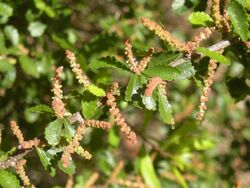Biology:Acalypha eremorum
| Acalypha eremorum | |
|---|---|

| |
| Acalypha eromorum flowers and foliage | |
| Scientific classification | |
| Kingdom: | Plantae |
| Clade: | Tracheophytes |
| Clade: | Angiosperms |
| Clade: | Eudicots |
| Clade: | Rosids |
| Order: | Malpighiales |
| Family: | Euphorbiaceae |
| Subtribe: | Acalyphinae |
| Genus: | Acalypha |
| Species: | A. eremorum
|
| Binomial name | |
| Acalypha eremorum Mull.Arg.
| |
Acalypha eremorum is a species of shrubs of the plant family Euphorbiaceae, endemic to Queensland, Australia. Commonly known as soft acalypha, turkey bush or native acalypha . The species grows as an open branched shrub to 2 m tall with small leaves with crenate margins. Plants may shed their leaves in response to prolonged drought. Branches often end in spines, especially on smaller plants. Small flowers are produced in spikes throughout the year and are followed by deeply lobed capsular fruit.[1][2][3]
Acalypha eremorum occurs naturally in forest understorey, primarily in the drier closed forest types such as vine scrub though occasionally in open forest.[1] It has also been brought into cultivation as an ornamental garden plant.
References
- ↑ 1.0 1.1 "Acalypha eremorum". Centre for Australian National Biodiversity Research (CANBR), Australian Government. 2020. https://apps.lucidcentral.org/rainforest/text/entities/Acalypha_eremorum.htm.
- ↑ "Acalypha eremorum (Euphorbiaceae); Soft acalypha, turkey bush". Brisbane Rainforest Plants; Brisbane Rainforest Action & Information Network. Archived from the original on 13 May 2013. https://web.archive.org/web/20130513213034/http://www.brisrain.webcentral.com.au/01_cms/details_pop.asp?ID=612. Retrieved 12 May 2013.
- ↑ "Acalypha eremorum Mull.Arg." (Website at bie.ala.org.au/species/Acalypha+eremorum). Atlas of Living Australia. http://bie.ala.org.au/species/Acalypha+eremorum. Retrieved 15 May 2013.
Further reading
- Melzer, R., 2007 “Plants of Capricornia”. Capricorn Conservation Council. Rockhampton.
Wikidata ☰ Q4671679 entry
 |

